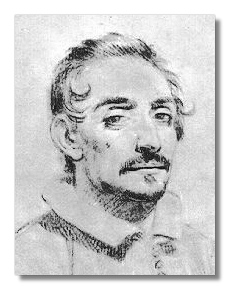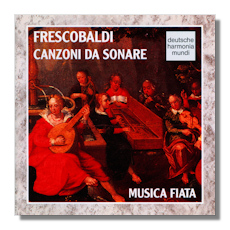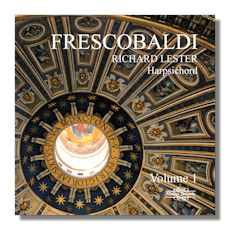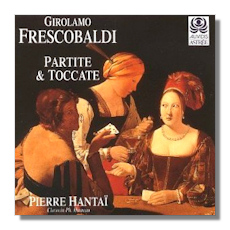
The Internet's Premier Classical Music Source
Related Links
-
Find CDs & Downloads
Amazon - UK - Germany - Canada - France - Japan
ArkivMusic - CD Universe
Find DVDs & Blu-ray
Amazon - UK - Germany - Canada - France - Japan
ArkivMusic-Video Universe
Find Scores & Sheet Music
Sheet Music Plus -
- Frescobaldi Experience by Richard Lester
Recommended Links
Site News
Girolamo Frescobaldi

(1583 - 1643)
Frescobaldi (baptized mid-September 1583 - March 1, 1643) is one of the most important composers in the history of keyboard music, and one of the most famous representatives of the early Italian Baroque. His output exhibits many deep contradictions, and his ability to unify these various poles is one measure of his compositional genius. Frescobaldi was born in Ferrara, possibly into an influential family, and took up the organist's post at St. Peter's in Rome in 1608. Although a prestigious position, Frescobaldi's circumstances were such that it never amounted to more than a small fraction of his income. His patrons were many, and consistently among the highest circles of Roman society. In addition, he had short-lived official positions in Ferrara, Mantua, and Florence. Frescobaldi's activity late in life is not well-documented, but by then his fame would have been substantial. Indeed, he can easily be named as one of the earliest superstar virtuosos.
Although known in his lifetime primarily as a performer, Frescobaldi's compositions continued to be closely studied in Italy for more than a hundred years after his death. Froberger left his Viennese post for three years to study with him, and subsequently diffused many of his ideas indirectly through Germany & France. Later still, the young Johann Sebastian Bach copied out his Fiori Musicali by hand, one of two such foreign publications (together with Nicolas De Grigny's Livre d'orgue) to earn this distinction. Although Frescobaldi's synthesis of existing Italian regional keyboard styles is advanced and complex, his influences can be given rather succinctly. The teacher he credited directly was Luzzasco Luzzaschi in Ferrara, from whom he certainly inherited a disposition toward writing out ornaments. Likewise, Gesualdo's stay in Ferrara was clearly influential, and indeed Frescobaldi's accomplishments in providing continuity to seemingly disparate material can be linked directly to Don Carlo Gesualdo's convoluted but strictly harmonically-based vocal modulations. Perhaps it is most easy to see Frescobaldi's earlier reflections in the related Neapolitan keyboard output of Giovanni De Macque and his circle. Finally, while of a different disposition than the Venetian school, Frescobaldi's development of the toccata clearly rests on those of Claudio Merulo, as does his formal constitution of Fiori Musicali. Nonetheless, his summations are uniquely his own, often bizarre in their simultaneous excess and conservatism.
While Frescobaldi's style of playing was hailed as brilliantly original and definitively progressive to the point that subsequent performers could not dream of doing other than adopting it, and his counterpoint is frequently so novel as to be disturbing to conservatives, his use of form and harmony was far too old-fashioned for the modernists. He pioneered no new forms, nor indeed used any that were not more than fifty years old. His keyboard works do not exhibit clear separation between melody and harmony in the bass, nor do they adopt the phrasing of the emerging monody. In these ways Frescobaldi was clearly old-fashioned, yet his compositions are so strikingly original in conception that virtually nothing of the era sounds like them. He was also an obsessive "corrector" of his own work, to the point where many of his major compositions were modified several times, and some added or dropped entirely in different editions of the same publication. One can hardly judge these corrections unsuccessful, however, as they frequently add to the sense of continuity in the various sections. Frescobaldi's prowess at the keyboard was balanced by an apparent lack of education, to the point that it was seriously suggested that he did not understand the words he set to music and indeed that his own unedited writing was virtually unintelligible. His relatively modest published vocal music is of no historical interest aside from helping to illuminate his music as a whole.
Frescobaldi's approach to more rigorous forms is frequently contradictory. While using such advanced techniques as melodic inversion and even simultaneous four-part contrapuntal development, he confuses formal schemes (to the point of dropping one capriccio from a subsequent edition because it is actually a partita) and often does such things as including unprepared episodes in variation sets. Frescobaldi also exhibits a sense of humor with regard to musical forms, and especially in his approach to mode and hexachord. In this way, he is in some aspects a precursor to Mozart. Nonetheless, Frescobaldi emphasizes linear contrapuntal development at the expense of the new harmonic schemes, and includes various unexpected twists even in his fantasias and ricercari. In that sense, the latter are barely recognizable next to the learned and smoothly flowing originators of the form a century earlier in Adrian Willaert's circle in Venice. Frescobaldi did enthusiastically adopt the new rhetoric of affetti, melodic twists deriving from the madrigals of the period and intended to represent specific individual emotions. He combined these figures in baffling kaleidoscopes for his toccatas, even those intended for religious services. Indeed his sacred music is an odd combination of smooth harmony and convoluted secular figures over bass ostinatos. However, it is especially in his ability to string together seemingly unrelated episodes of virtuosic passagework and project grand nonlinear forms from the smallest elements that Frescobaldi's compositional abilities are fully demonstrated. His playing technique involved frequent changes of pace and dynamic, and a sensitive appreciation of the smallest nuance is consequently integral to realizing the continuity in his music.
In 1608, the year of his appointment to St. Peter's, Frescobaldi issued his first two major publications, a set of open-score fantasias in each of the twelve modes, and a book (his First and only, although others appeared in various anthologies) of madrigals. The fantasias are particularly unrelenting in their texture (perhaps influenced by his visit to Brussels in that year, where he almost certainly met Cornet and Philips), but do show some interesting contrapuntal ideas as well as a restless imagination. The madrigals are clearly his best vocal works, comparable to the contemporary works originating in Ferrara, but not commanding respect on their own. Frescobaldi's development from there is somewhat mysterious, but in 1615 he issued a book of ricercari along with his most famous publication, the First Book of Toccatas. The former are essentially similar to the earlier fantasias, although less uniform in their texture and given to frequent alteration of mood. The latter represents a substantial leap, and consists of twelve toccatas followed by a group of partitas on ubiquitous tunes of the era. It was reprinted five times, making it Frescobaldi's most popular book and still the central one in his oeuvre. In subsequent printings, changes were made to the toccatas and several new compositions were gradually added. This is the heart of his output, presenting a dazzling array of figurations and modulations which manage to yield a coherent whole almost in spite of themselves. It is in the preface that Frescobaldi describes his intended manner of performance, asking that the pulse be flexible and that phrasing adopt an improvisatory spirit. Although the preface also suggests that the performer can stop playing at the end of any section, this is more likely for commercial reasons, due to the increasing virtuosity and consequent difficulty of successive sections.
In 1624, Frescobaldi published his book of caprices, essentially taking up the thread of the fantasias and ricercari with which he had opened his output. In this case, the counterpoint is both more individual and more impressive. His sense of humor and trickery also come through, although it must be added that the derivation of the term "capriccio" (used since the mid-16th century) is entirely analogous to that of "fantasia", such that an added degree of unpredictability would not have been implied by the title alone. In 1627, Frescobaldi published his Second Book of Toccatas, including eleven toccatas (four designated specifically for organ for the first time) as well as variation sets, dances, canzoni, and now cantus firmus pieces to alternate with chant. The second book is generally more involved in its harmonic relationships and smoother in its rhythmic contours than the first. Frescobaldi first published his book of instrumental canzoni in 1628. This had been a popular form with Gabrieli, and was used by several composers of the early 17th century until falling out of fashion by the time Frescobaldi took it up (as was so often the case). His general approach is quite comparable to that of the Neapolitan Giovanni Maria Trabaci, although the characteristic triple-time figures combined with fugal development seem to have fit his artistic voice especially well. The book was completely revised in 1634, such that almost no measure was unchanged, including the removal and addition of entire canzoni. In the interim, during his stay in Florence, Frescobaldi issued two books of songs in 1630 entitled "Arie Musicali". These are of simple harmonic outline, with a combination of ornate soprano voices set against a slow-moving bass, and are thus anomalous in his output. The form, apparently looking back to Luzzaschi, was completely out of fashion in the wake of Giulio Caccini, and Frescobaldi's reasons for issuing the book are unclear.
Frescobaldi's most famous work in Germany was his Fiori Musicali for organ, published in 1635. This was the book which Bach had copied by hand, and it remains a summit of Baroque organ music. It consists of three organ masses, made up primarily of verse elaborations to alternate with chant for the Kyrie, as well as toccatas for the Elevation of the Host, and a few other more complex pieces (ricercari & canzoni) to be performed at specific points during the service. True to his contradictory nature as a composer, two capriccios on secular themes are also included without clear motivation. Indeed, the entire publication infuses the typical organ styles of the time (and the manner of publication is derived directly from Merulo) with various secular figures and other restless modulations. The resulting chromatic harmony, especially in the toccatas, has been the subject of admiration ever since. In 1637, Frescobaldi published the last and most substantial revision to the First Book of Toccatas, including several new pieces. The more than one hundred variations on the passacaglia bass written at this time are among his most impressive achievements. Finally, his published output is concluded with a small set of keyboard canzoni, published posthumously in 1645. It is unknown when these pieces might have been written, although a much earlier date is suspected, and they curiously mirror the handful of canzoni he had engraved prior to his career in Rome.
Frescobaldi's large and impressive output of keyboard music consistently shows his ability to inject older forms with newly complicated harmonic relationships. It is thus a contradictory blend of old and new, undertaken from a perspective which his contemporaries apparently did not share. While the other major figures of the early Italian Baroque adopted the new monody and basso continuo with zest, Frescobaldi retained an orientation toward severe counterpoint invested with his own particular brand of drama. Any deficits in his education were certainly compensated by the innate harmonic and rhythmic sense which made this possible. The resulting originality is certainly part of the reason his music still stands out today. ~Todd Michel McComb (8/97)
Recommended Recordings
Instrumental Canzoni
- Canzoni da sonare/Deutsche Harmonia Mundi 77313
-
Musica Fiata Köln/Roland Wilson
- 19 Canzonas, Volume 1/Nuovo Era 7131
-
Kees Boeke/Tripla Concordia
Amazon - UK - Germany - Canada - France - Japan
And Volume 2 on Nuovo Era 7250 2CDs:
Amazon - UK - Germany - Canada - France - Japan
- Canzoni/EMI Reflexe CDM763140-2
-
Kees Boeke (recorder), Wouter Möller (cello), Robert van Asperen (harpsichord)
 Harpsichord/Organ Music (
Harpsichord/Organ Music ( Toccatas, Capricci, etc.)
Toccatas, Capricci, etc.)
- Partite & Toccate/Astrée 8585
-
Pierre Hantaï (harpsichord)
- Toccatas, Caprices, Partitas, etc./Dorian Recordings DOR-90124
-
Colin Tilney (harpsichord)
- Toccatas, Partite sopra l'Aria della Romanesca, Capriccio "Or che noi rimena", etc./Nimbus NI5850
-
Richard Lester (harpsichord)
- Complete Toccatas from Book I/Tactus TC580680 or TC580601
-
Sergio Vartolo (harpsichord & organ)
- Complete Toccatas from Book I/Arcana 904
-
Rinaldo Alessandrini (organ)
- Capricci Book I/Deutsche Harmonia Mundi 77071
-
Gustav Leonhardt (organ & harpsichord)
- "Fiori musicali" I (organ masses, volume 1)/Deutsche Harmonia Mundi 77331
-
Lorenzo Ghielmi/Canticum
- "Fiori musicali" II (organ masses, volume 2)/Deutsche Harmonia Mundi 77345
-
Lorenzo Ghielmi/Canticum
















